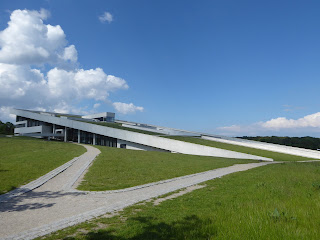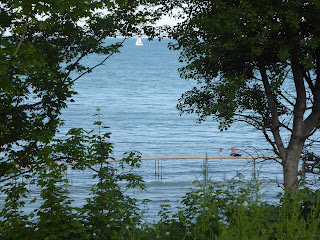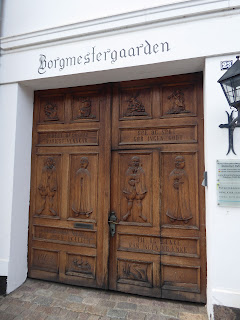There
was heavy overnight rain but fortunately it stopped just as we were
departing Ebeltoft. Nevertheless it was a dull and damp
morning with no sign of the promised N F4 wind that had been
promised. Instead we had to motor with very light and variable winds.
25nm later we passed across the entrances to the main commercial and
ferry harbours at Aarhus and entered the sailing club harbour,
Sejlklubben Bugten. As we got nearer we had noticed the dramatic
new residential developments now eating into the space that once
accommodated docks for numerous sailing barges.
 |
| New homes as we passed the main docks |
 |
| Ebeltoft to Baago (track in orange) |
In
the afternoon we wandered around the centre of Aarhus. We saw a few
historic streets and buildings, churches, including one originally
with a monastery; viewed the inside of the AroS building but decided
not to spend time in the galleries; were appalled by the stark grey
Radhus, supposedly a design icon; and went out on the roof terrace and
walkway over the main street provided by Sellings Department store.
 |
| Main shopping street from cantilevered walkway |
The
next day was sunny and we cycled 10km out into the countryside to the
excellent Moesgaard Museum. Not only is it in a relatively new and
very impressive concrete building but it is also very well presented.
Its focus is on people in Denmark from the Stone Age through to the
Middle Ages. Their highlight was Grauballe Man, “the world's best
preserved bog body”, from about 2000 years ago. Well worth visiting
and we had a pleasant ride through woods alongside the coast.
 |
| Moesgaard Museum | | | | |
 |
| Cycling back through the woods passing some of the beaches |
 |
| Passing Moesgaard from the sea the next day |
The
following day was again sunny. But the wind had now unhelpfully
turned to S right on the direction we needed to head, so it was motor
again, this time 28nm to the small island of Endelave. We had
various shallow banks and a wind farm to pass en-route and as we
followed the limited buoyage down a channel between very shallow
water, I could see the ferry tied up at the harbour entrance and
began to wonder how much space there was to enter. It is tight
necessitating a very full turn to starboard around one mole and
passing close to the stern of the ferry, but we were in to a very
quiet rural harbour.
 |
| Endelave, not busy! |
We
walked around the village and a little way outside it during the
afternoon. We found the villlage shop and bought a couple of items
and then further out a smokery that provided salmon and herring.
 |
| Mixed crops in fields |
 |
| The Church, a conspicuous landmark from sea |
 |
| Part of the main street |
Saturday
morning's forecast had been for very strong winds but that was of no
concern as we planned to spend two days at Endelave. We didn't get strong winds but all morning we had heavy rain. The morning
ferry brought about 60 or so people including groups of young people
including scouts heading for a camping break and quite a few
holidaymakers and friends of locals who were met by a mixture of
transport. This ranged from vintage cars to tractor drawn “buses”.
Sunday
16 June was sunny again and we sailed 28nm in a SW3/4 to Bogense
a small town on Fyn. This is an island but of considerable size.
Bogense was busy (by Danish standards) with quite a few visitors
around the harbour. This is a delightful town, well worth a visit.
Beautiful old buildings with attractive streets in the town centre.
 |
| Mother and child statue at Radhus (Town Hall) |
The
Harbour area had also benefited from environmental improvements and new buildings.
 |
| Looking good in the evening sun |
The next day was again sunny and initially we were able to sail
close hauled into a SW4 heading towards Middelfart. Once we
got to the narrow channel between Fyn and Jutland we were headed by
the wind funnelling through so motored for awhile. This is the
Lillebaelt (Little Belt), said to be where the Kattegat meets the
Baltic Sea. The Lillebaelt is both narrow and very deep, formed by a
glacier during the last ice age. At its narrowest it is 1km wide, at
its widest 15km. One of the deepest places is 80m deep. It is fringed
with a mixture of industry and beech forests on steep cliffs,
altogether very attractive.
 |
| Heading towards the relatively new bridge across the Lillebaelt at Middelfart |
After having looked at a couple of
harbours in the town we chose to continue around the peninsular to
the Middelfart Marina on the south side. Whilst it is a 20 minute
walk into the old town from there, the setting is much more
attractive as you look across to beautiful coastline and woods
The town has some attractive historic buildings; but also plenty of modern additions some of which are well designed but many of which leave a little to be desired! Maybe we were also put off as much of the town centre has environmental improvement work underway, with roads and footways dug up!
 |
| Merchants House dating from 1580 |
We
had two mainly sunny days in Middelfart but late on the second day
there was a dramatic thunderstorm, a pattern that was to follow for
the next 24 hours.
On
Wednesday 19 June it was a still humid morning. We motored S enjoying
sunshine but watching the black clouds building until we were
subjected to our dose of heavy rain, thunder and lightening. As it
began to move away we headed into the harbour on the small island of
Baago.
 |
| The small harbour |
 |
| Small ferry too, goes to Assens only 30 minutes away |
This tiny island is largely a nature reserve with a
population of around 25. It is typical of this style of small Danish
islands. Few cars, few houses (mostly concentrated in one place) and
a ferry a couple of times a day. What you also get, which is
unimaginable in the UK, are “honesty boxes” for use when you wish
to buy produce for sale at the farm gate or, in Baago, for bicycle
hire from the harbour and serve yourself refreshments in the small
island museum. These included hot and cold drinks, ice creams etc. Even
beer in the fridge. How long would any of this last in the UK before
light fingered people took the lot, honesty box contents and all?
The museum itself had interesting historical photographs and stories about the island. Also a wealth of domestic and farming equipment mainly from the late nineteenth and twentieth centurys.
we had to be careful when walking around the three rooms as swallows flew through the door and around the rooms, possibly feeding their young in a nest somewhere in the roof of the largest room with the farming exhibits.
The sun disappeared in late afternoon and a couple of hours of thunderstorms and strong winds followed. Unsettled weather typical of this June in Denmark.








































No comments:
Post a Comment